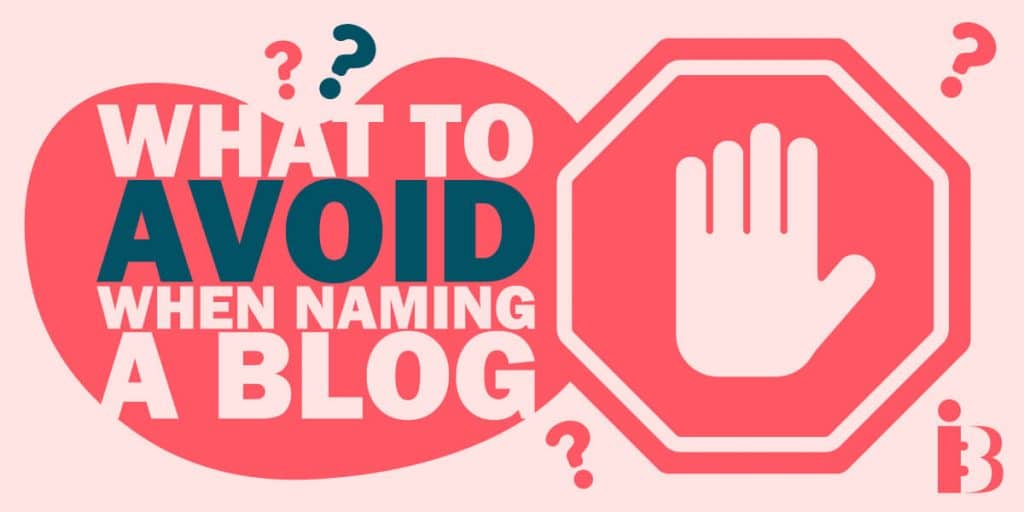Playback speed:
Coming up with compelling blog name ideas can be challenging.
Even if you know exactly what you want to write about, it’s difficult to choose a title that’s guaranteed to grab the attention of your reader. That’s particularly true now that there are over 500 million blogs on the internet for new creators to compete with.
There’s a good chance many of the most “obvious” blog titles in your industry have already been taken. This means you need to be substantially more creative if you want to stand out.
For many bloggers, it can be tempting to simply choose a placeholder name and hope the quality of their content will outweigh a meaningless moniker. However, the reality is that your name is a core component of your brand, and your ability to connect with your audience.
Your name is the first insight your readers get into your tone, personality, and even the central focus of your blog. Fail to get this element right, and you could risk losing crucial traffic.
Here, we’re going to share some helpful tips, guidance, and inspiration, designed to make your search for the ultimate blog name a little easier.
What Makes a Good Blog Name?
A great blog name is like a memorable first impression—it should be clear, unique, and leave a lasting impact. Think of something catchy and ensure that the domain name is available.
Steer clear of overly complicated or generic names, and always check for any potential trademark issues before you start a blog. A good blog name should grow with you, giving your blog room to evolve, and it should evoke positive vibes to attract and retain your audience. So, find a name that not only fits your blog today but also sets you up for a successful and memorable blogging experience.
Coming Up With a Blog Name: Finding Your Niche & Audience

One of the first steps in choosing effective blog name ideas is making sure you understand your blog niche. The perfect name should not only provide your readers with insight into what you’re going to be writing about but also help you connect with your audience on a deeper level.
With this in mind, ask yourself exactly where you’re going to be focusing your attention. Remember, the narrower your niche, the more competitive your blog will be. For instance, rather than writing all about content marketing, you could produce a successful blog solely focused on SEO. If you’re interested in creating a travel blog, you might focus on local, rather than international travel.
Make sure there’s an audience for your niche before you start blogging. You can do this by checking sites like Google Trends, and examining how many existing blogs are already available in your space. Assessing your competition will also give you an idea of how you should be building your own blog and brand. When you’re looking at top-ranking sites in your industry, ask yourself:
- What kind of name does this blog have?
- What is the brand identity of this company?
- What kind of audiences does this blog attract?
Once you know your niche, you can begin to focus more heavily on your target audience. This means deciding who your ideal reader is going to be. No blog will appeal to everyone, so try to avoid creating anything too generic. Instead, you should be focusing on creating posts that are relevant to the specific interests and pain points of a certain group.
For instance, if you’re going to be writing a blog in the cooking niche, ask yourself what kind of chefs you want to appeal to. Are you writing for professionals or home bakers? Do you want to specifically focus on recipes for vegans, vegetarians, or those who eat gluten-free foods?
Before you begin blogging, it can be helpful to draft some audience personas. Ask yourself what kind of age range your customers fall into, where they come from, what they do for a living, and even how much they earn. What’s their level of education, and what are their biggest concerns or fears? All of these questions will help you to determine what your blog should be about.
Finding Your Personality: Tone of Voice
Once you know your niche and audience, and you’ve taken a closer look at some of the competitors in your space, you can begin working on your brand identity. As mentioned above, your name should be a core element of the brand you create when building a blog or website.
A brand isn’t just a logo or color palette, it’s everything that contributes to the specific experience you give your audience when they interact with you. Your brand influences how you connect with your audience on an emotional level, and how they perceive your business.
With this in mind, think about the kind of vibe you want to create.
Do you want people to see your blog as an authoritative source of valuable, educational information? Are you hoping to stand out as a thought leader in your industry, or give your readers the impression that you’re fun and laid back? Would you rather be a resource for big-spenders, or people focusing on maintaining a small budget? Knowing these things will help you to define your blog’s essence.
The blog name ideas you choose should instantly give your customers an insight into what they can expect from your company. For instance, the name “Growth Collective” makes us think of ambition and community, while the name “Pro Blogger” makes us think of professionals and expertise.
Should I Use My Real Name for My Personal Blog?
You can name your blog whatever you want, but it mostly depends on your goals and the nature of your content. Using your own name can be a great choice if you want to create a personal brand and establish yourself as an authority in your niche.
However, unless you come with a pre-established audience, it can make it more difficult to attract readers to your new blog. If you’re about to launch a more general lifestyle blog, using a niche-specific term in your brand name might be more suitable.
But you can still use your name as a part of your brand by combining it with a relevant keyword. Say you’re going to write about traveling, your travel blog name can be something like “YourNameTravels” or “YourNameTravelAdventures”. This way readers will easily be able to tell what your content is about, and you’ll have a unique blog name with a personal twist.
Choosing Creative Blog Name Ideas: Brainstorming
With a clear view of your market and your brand identity, it’s time to start brainstorming.
The important thing to remember when you’re brainstorming initial blog name ideas is that you don’t have to choose the perfect title straight away. Initially, your focus should be on getting as many different options down on paper as possible, so you have a platform to work with.
If you’re developing your blog on your own, it might be worth getting some input from friends and family members to help expand your list of potential names. If you’re working with someone else, you can bring their ideas into the mix too. Here are some helpful ways to maximize your brainstorming session.
1. Use a Thesaurus
It’s hard to generate a rich selection of different words off the top of your head. A thesaurus can be extremely helpful. It will help you come up with a range of synonyms and alternative phrases based on the core ideas you associate with your blog. For instance, if you want your blog to make people feel happy, you could experiment with words like Joy, Elevate, Excite, and Cheer.
Examples: Mind Hacks (Psychology), Wholesome Cook (Food), InBound Blogging (Marketing)
2. List words related to your industry
Listing words related to your industry is also a constructive strategy during your brainstorming session. After all, using an industry-specific term in your blog title should help to tell your audience what your content is going to be about. For example, in the travel industry, you might use words like Adventure, Explore, Passenger, Flight, Baggage, and so on.
Examples: Nomadic Matt (Travel), Atlas and Boots (Travel), Pinch of Yum (Food)
3. Play with different types of words
Adverbs, adjectives, verbs, and nouns can all form a part of your blog name ideas. Think about how you might want your customers to describe your blog, or what you want to be associated with. You could even consider adding your own name to your moniker if you want to make your blog feel more friendly and human.
Examples: Cookie and Kate (Food), Desire the Dress (Fashion), Beating Betting (Sports)
4. Invent New Words
If you’re struggling to come up with a word that fully describes your brand vibe or the blog you’re trying to create, you could consider making up something yourself. One of the easiest ways to create an invented name is to start with a word most people will already be familiar with, and build on that. This helps to make your name more evocative.
Examples: Examples: Velio(Technology), Geico (Insurance), Grubero (Technology), Glamela (Fashion)
5. Combine words into a compound name
Another way to create a fantastic set of blog name ideas is to combine multiple terms together. Using the list of names you’ve already created, try pushing some of them into a compound name. For instance, “Cupcakes and Cashmere” is a lifestyle blog that immediately highlights the two focus areas of the content: fashion and food.
Examples: Barefoot Blonde (travel and lifestyle), Curls and Pearls (Beauty and Lifestyle)
6. Play with humor

Blogging doesn’t always have to be serious. If you want to convey a fun and playful persona, it’s worth experimenting with a little humor. Consider using puns to make your readers laugh or smile when they read your name. Using humor correctly can be a great way to ensure you stay top of mind with your readers, and attract more visitors.
Examples: Fit Bottomed Girls (Health), Cats Who Code (Technology), The Lazy Baker (Food)
7. Try unrelated words
While it’s usually easier to come up with an effective blog name using words related to your industry, it can be helpful to experiment with unrelated words too. For instance, the word “Republic” wouldn’t usually be connected to the cooking industry, but it creates a sense of sophistication and community for the blog in question.
Examples: The Inspired Table (Food), Yoga Dork (Health), Tiny Buddha (Health and Wellness)
If you’re looking for inspiration about blog names, I have an article about the best healthcare blogs with their names and what they’re all about. Check it out!
Expand Your Naming List to Find the Right Blog Name

If, after using all of the strategies above, you still don’t have a clear set of names you feel comfortable with, it might be worth trying a few additional tactics. One of the best ways to expand your naming list is to experiment with lexical strategies, such as:
- Alliteration: Alliteration is a great way to make a name more memorable. It also makes it a title easier to say, so it can encourage word-of-mouth marketing. Look for words that blend naturally together with the same first letter, such as Barefoot Blonde, or Cupcakes and Cashmere.
- Portmanteau: A portmanteau involves combining two words into one new word, by removing certain letters. For instance, Spork is a combination of a spoon and fork. Combining two words together is a satisfying way to make your name a little shorter and easier to remember.
- Translations: Consider translating one of the words in your compound name to add a twist to your title. For instance, Miel (Honey) pot could be a great name for a cooking blog. Double-check the translations before you commit to a name.
Try a Blog Name Generator
Name generators aren’t the best tool for naming a blog or company, as they’re limited in the creative solutions they can offer. However, they can be a good tool for expanding your list of potential blog name ideas. They often work by suggesting synonyms and compound words based on the terms you input into a search bar. This can give you more inspiration to work with.
Here are a few name generators you can try:
- Looka: The Looka name generator not only provides you with insights into potential blog names but also helps you check domain and social media availability as you search.
- Nameboy: A convenient and free domain name generator tool that can help you pinpoint specific names based on your interests, niche, or target audience.
- Wordoid: Wordoid is a good option if you’re interested in compound or created words, as it can combine multiple different terms together into something unique.
- Themeisle: Themeisle is another excellent solution for finding blog name ideas, with various options available based on the keywords you enter.
- DomainWheel: DomainWheel is a free online tool that allows you to search for potential names, and find out whether they’re available to purchase at the same time.
Check If The Name Is Available
One of the most important steps in narrowing down your available blog name ideas is making sure any title you like is actually available for you to use. As blogging and content marketing become more popular, countless new websites have popped up around the world. This means many of the titles you may like could already be taken.
There are a few ways to check whether your blog name is available. The first option is to simply type the phrase into Google and see what comes up. You can also consider doing a trademark search in your local region. However, the easiest solution is to search for available domains with a hosting provider. Most hosting companies will allow you to check for name availability with a simple search bar. If the name is available to buy, you should be able to use it.
It’s also worth checking to see whether anyone is already using your ideal blog name on social media. Even if someone hasn’t purchased a domain, they could still be using your blog title as their handle or social username, which could make it harder for you to expand your marketing strategies in the future. And even if you don’t plan on promoting your blog on all platforms, create an account to secure the username just in case.
If your name is available, it’s important to buy it as quickly as possible, to prevent other people from jumping in. You may even want to consider buying different versions of your name with multiple TLDs, such as: bloggingpro.com, bloggingpro.net, and bloggingpro.co.uk.
What to Avoid When Naming Your Blog

One of the biggest challenges when choosing a catchy name for your blog is knowing what you should avoid when you’re sorting through your ideas. Just as the right name can improve your chances of attracting readers, and provide more monetization options, the wrong name can have disastrous results. Whether you’re creating an anonymous blog, or using your blog to build your own personal brand, make sure you don’t:
- Make the name difficult to spell: When you’re trying to make your blog stand out from various competitors, it’s tempting to experiment with misspelling words. A misspelled word is often more memorable than its counterpart. However, it can sometimes look unprofessional and may make it harder for your readers to find your content.
- Use cliches: Cliches are another problematic issue within blog naming. Though they might sound fun at first, they often look boring and unoriginal to your readers. Try to think outside of the box and choose a name that demonstrates your values and creativity.
- Choose a long name: Long names are harder to remember, more difficult to type, and can make it less likely that your customers share links to your blog posts. Where possible, it’s worth keeping your name as short as possible.
- Copy other brands: Finding inspiration for your blog name ideas by looking at your competitors is fine. However, simply mimicking their name won’t get you any readers, and it could harm your reputation. You could even put yourself at risk of a trademark dispute.
- Forget to research: Most of all, don’t forget to do your due diligence. Make sure your name looks right when all of the words are placed together in a URL. You don’t want your audience to misread your moniker. It’s also worth double-checking the meaning of any terms before you commit to a name.
15 Creative Blog Name Examples to Get You Started
As mentioned above, one of the best ways to boost your chances of coming up with a good name for your blog is to examine the current market and check out your competitors. We’ve already shared some useful examples above, but here are a few more name suggestions to inspire you:
| The Growing Creatives | A site about raising creative kids, with blogs on creative play ideas, crafting, and incorporating creativity into learning opportunities. |
| Learn to Code with Me | This blog is all about teaching youngsters how to code. The name is welcoming and friendly, so it’s more accessible to a younger audience. |
| The Verge | This multimedia blog chose its name to convey a sense of being “cutting edge” to its target audience. The verge is a name that reminds us of progression. |
| Lazy Cat Kitchen | Some of the best names use imagery to their advantage. This playful name for a food blog makes us think of relaxation and comfort. |
| Nerd Fitness | This blog in the fitness niche is simple and descriptive. It tells us exactly what to expect from the tone of voice in the content. |
| Expert Vagabond | This fantastic name for a travel website makes us think of a person who breaks free from typical conventions and thinks outside of the box. |
| Copyhackers | This world-renowned copywriting blog tells its readers they’ll learn how to “hack” the web with their copy, through a simple compound term. |
| The Music Ninja | We associate ninjas with power and stealth. The name “The Music Ninja” makes us think of a professional individual, with a behind-the-scenes view of the industry. |
| The Art of Manliness | This male-focused blog immediately tells us what kind of customer it wants to attract with its name. It’s fun and playful, with a sophisticated vibe. |
| Repeat Crafter me | This pun-style name for a crafting blog is an excellent way to make readers smile. It feels fun and playful, but also tells readers they’ll learn something. |
| Wholesome Cook | The Wholesome Cook blog chose its name to make people feel warm and welcome. It’s a descriptive name with an evocative edge. |
| Blogging Wizard | The Blogging Wizard blog tells people they’ll be able to discover magical ways of improving their content writing within the posts provided. |
| Eat, Sleep, Draw | This catchy blog name uses the rule of three to engage and captivate audiences. It feels descriptive and meaningful at the same time. |
| Workout Mommy | The Workout Mommy blog has a fantastic name because it appeals directly to a unique audience – mothers who want to find a way to stay fit. |
| Jeff Bullas | The Jeff Bullas blog uses the name of the writer as its moniker. This tells us exactly who is responsible for the company, and builds on the marketer’s personal brand. |
Ready to Find the Perfect Blog Name?
Coming up with blog name ideas can feel like a daunting task at first, particularly when so many amazing names have already been captured by other brands. However, with a little patience and creativity, you can choose a title that resonates with your target audience.
Once you have your name, you’ll be able to start building on your brand, creating your website, perfecting your tone of voice and even producing an eye-catching logo.



